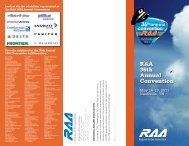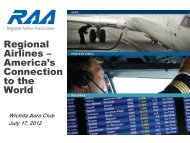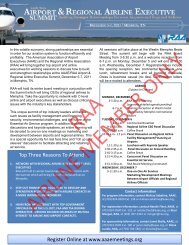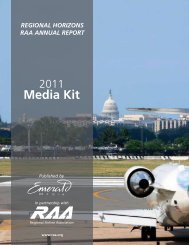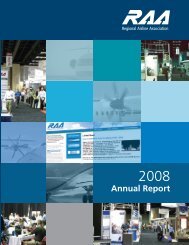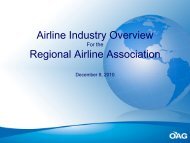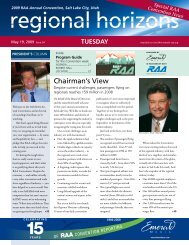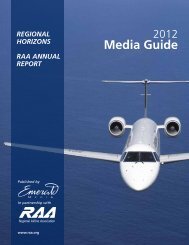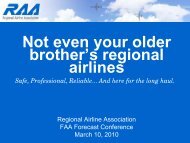Comments - Regional Airline Association
Comments - Regional Airline Association
Comments - Regional Airline Association
Create successful ePaper yourself
Turn your PDF publications into a flip-book with our unique Google optimized e-Paper software.
IV.WebsitesA. ProposalThe Department proposed that carriers meet certain web accessibility standards in a 3 phase or“tier” approach. The first phase or tier requires that any new or redesigned website placed onlinewithin 180 days of the final rule must conform to WCAG 2.0 Levels A and AA. The secondphase or tier would require a carrier to provide seven core functions that conform to WCAG 2.0Levels A and AA on the carrier‟s primary website or on the carrier‟s mobile website within oneyear of the final rule effective date. Phase or tier 3 would require a carrier to conform allwebpages on its primary website (any website that includes the carrier name in the url) toWCAG 2.0 Levels A and AA within 2 years of the final rule effective date. Finally, theDepartment proposed that carriers ensure that the website of ticket agents on which the carriermarkets its airline tickets also conform to WCAG 2.0 Levels A and AA within two years of thefinal rule effective date. 19B. The Department Should Adopt Regulatory AlternativesWe support taking incremental steps to provide increase access to information and functions oncarrier websites that market air transportation. However, we believe that any regulatory mandatein this area take into account and recognize the substantial efforts by carriers to date to increasepassenger access to information on carrier websites. At the same time, as in the case with thekiosks, we believe it is incumbent of DOT to offer carriers a more flexible approach to meet thisshared goal of increased access. Carriers have already made substantial efforts to increasepassenger access to information on carrier websites, without a regulatory mandate to do so.These efforts have included incorporating accessible website features in newly developedapplications such as mobile websites or creating text alternative websites to better servepassengers with disabilities. The primary goal of these efforts has been to adopt usabilityfeatures, instead of limiting website development to strict standards. The result of these effortshas been to make the core and most important features of a carrier website accessible topassengers with disabilities. Many carriers use accessible website experts to maximize usabilityof carrier websites.The best way for the Department to meet its goals in this area is to change its proposedprescriptive website standard and provide additional flexibility. The Department should permitcarriers and ticket agents to meet any existing or future web accessibility standard. Adopting astrict “one size fits all” standard will unnecessarily divert carrier resources to comply withtechnical standards, when many of the estimated benefits have already been achieved or could beachieved in a much more efficient manner. Increased accessibility should embrace theinnovation, improvements, and features all passengers enjoy, such as carrier mobile websites orapplications downloaded onto a computer or smart device. Otherwise the unintended19 We note that proposed 382.57(c)(6)(iii) inadvertently refers to paragraphs (c)(6)(ii)(A) and (B) of this section,which do not exist. The intended reference was most likely (c)(6)(iii)(A) and (B) 76 Fed. Reg. 59327.11






